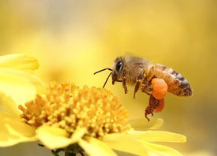- 阅读
- 阅读
- 技巧
- 百科
- 试题
- 文化
- 技能
This is Scientific American’s 60-Second Science. I’m Karen Hopkin.
这里是科学美国人——60秒科学系列,我是凯伦·霍普金。

And they found that the sounds were fairly similar.
他们发现这些声音非常相似。
You already know what hornets sound like.
你已经知道黄蜂是怎么叫的了。
And the bats do a pretty good job of replicating that ominous hum.
蝙蝠很好地复制了这种让人心生不祥的嗡嗡声。
But even more interesting, when the researchers filtered the audio to include only the frequencies that can be heard by owls--the bats’ main predator--the soundprints were even more alike.
但更有趣的是,当研究人员过滤音频,只留下能被猫头鹰(蝙蝠的主要捕食者)听到的频率时,声纹甚至更相似。
Of course this was just the first step.
当然,这只是第一步。
But then we had to see how an owl would react to these sounds.
然后我们要看看猫头鹰对这些声音会有什么反应。
Working with an avian rescue center, Russo and his colleagues exposed 8 barn owls and 8 tawny owls to the buzzy output of both bees and bats and they recorded the birds’ reactions.
罗素和他的同事与鸟类救援中心合作,将8只仓鸮和8只灰林鸮放置在蜜蜂和蝙蝠发出的嗡嗡声中,并记录了这些猫头鹰的反应。
In all such cases it was nice to see that the owls actually stepped back.
在这些情况下,很高兴看到猫头鹰真的后退了。
So it increased the distance from the sound source, ok, which was identified as a potential danger.
猫头鹰增加了与声源的距离,这被认为是一个潜在的危险。
So, the birds backed away from the buzz.
猫头鹰远离了嗡嗡声。
But what if owls just aren’t fond of noise in general?
但如果猫头鹰只是不喜欢一般意义上的噪音呢?
To test that out, the researchers conducted a control experiment, in which they broadcast some non-buzzy bats sounds.
为了验证这一点,研究人员进行了一项对照实验,在实验中,他们播放了一些蝙蝠的其他声音(非嗡嗡叫)。
And in that case the reaction of the owl was completely opposite.
在这种情况下,猫头鹰的反应完全相反。
Because the owl started to inspect the origin of the sounds.
因为猫头鹰开始检查声音的来源。
Probably because it was taken as a clue that a potentially tasty prey item was there.
可能是因为这种声音被认为是周围可能有美味的猎物的线索。
Interestingly, owls who were older when they were taken in by the rescue center were more perturbed by the cautionary buzzing than were birds that had been taken in as chicks.
有趣的是,被救援中心收养的年长的猫头鹰比年幼的猫头鹰更容易受到警惕性嗡嗡声的干扰。
This makes perfect sense because adult animals that had experienced the danger posed by stinging hymenopterans in the field will think twice before approaching a buzzing sound.
这是完全有道理的,因为成年动物在野外经历过膜翅目昆虫叮咬带来的危险,在接近嗡嗡声之前会三思。
While of course naive owls would not have this experience and would not rely on it.
当然,年幼的猫头鹰不会有这种经验,也不会依赖于这种经验。
The study was the first to find acoustic mimicry between a mammal and an insect.
这项研究首次发现了哺乳动物和昆虫之间存在声音模仿。
But based on the positive buzz, it probably won’t be the last.
但根据这种经过证实的嗡嗡声,这种情况不会是仅存的。
For Scientific American’s 60-Second Science, I’m Karen Hopkin.
谢谢大家收听科学美国人——60秒科学。我是凯伦·霍普金。
来源:科学美国人
参与评论